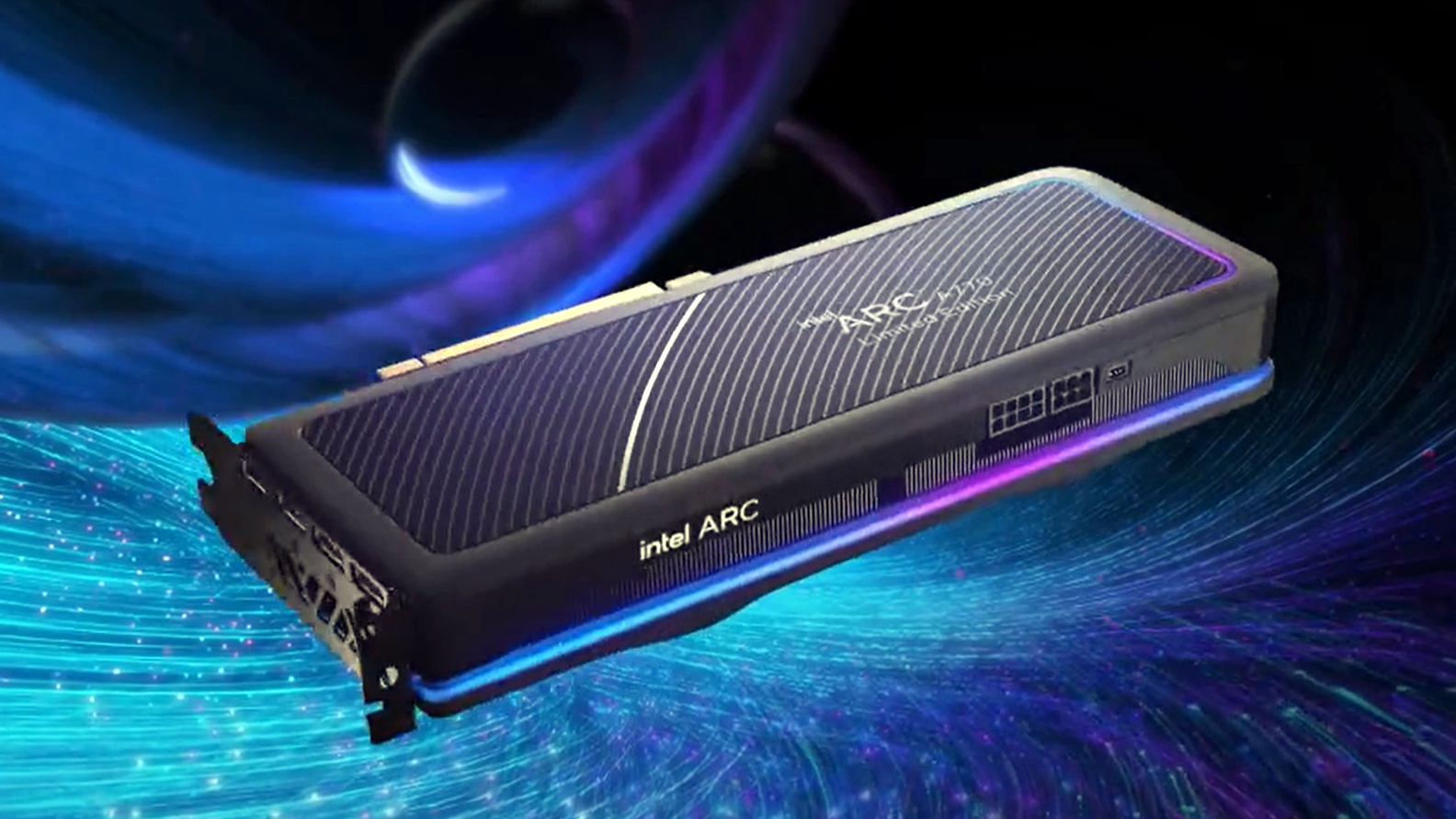Tom's Guide Verdict
The Axon 7 Mini doesn't make too many trade-offs from ZTE's flagship-worthy Axon 7. But this $299 phone's battery life holds it back.
Pros
- +
Terrific audio
- +
Stylish design in an affordable package
- +
Decent rear camera performance
- +
Colorful display
Cons
- -
Poor battery life
- -
Front camera falls flat
- -
Screen's a little dim
Why you can trust Tom's Guide
There's a smart idea behind ZTE's Axon 7 Mini: Take the company's Axon 7, which managed to pack premium specs into a sub-$400 phone, and dial down some of the features to knock even more off the price. The slightly smaller Axon 7 Mini may not give you the processing oomph you'd find in the Axon 7, but you do get a phone that will cost you $100 less. For many smartphone shoppers, that's a trade worth making.
Should the Axon 7 Mini's $299 price tag prove too tempting to pass up, you'll wind up impressed by the phone's stellar sound, solid display and good-enough camera, while you likely won't really mind its slow performance unless you use processor-intensive apps. But you'll also end up frustrated when the Mini runs out of battery life, which will happen far too early into your day.
UPDATE: As of June 21 2017, all Axon 7 Mini owners should have access to an over-the-air update that includes an upgrade to Android 7.1 Nougat. New features include multitasking mode, improved battery life, updated emojis and Wi-Fi calling for T-Mobile users.
Design: Top-of-the-line looks
Slapping a "Mini" tag on this phone is a bit of a misnomer. At 5.81 x 2.8 x 0.31 inches, the Axon 7 Mini isn't really that much smaller than the 5.97 x 2.95 x 0.31-inch Axon 7. The 5.4-ounce Mini sheds a little bit of weight from its sibling (6.2 ounces), though not enough to notice.
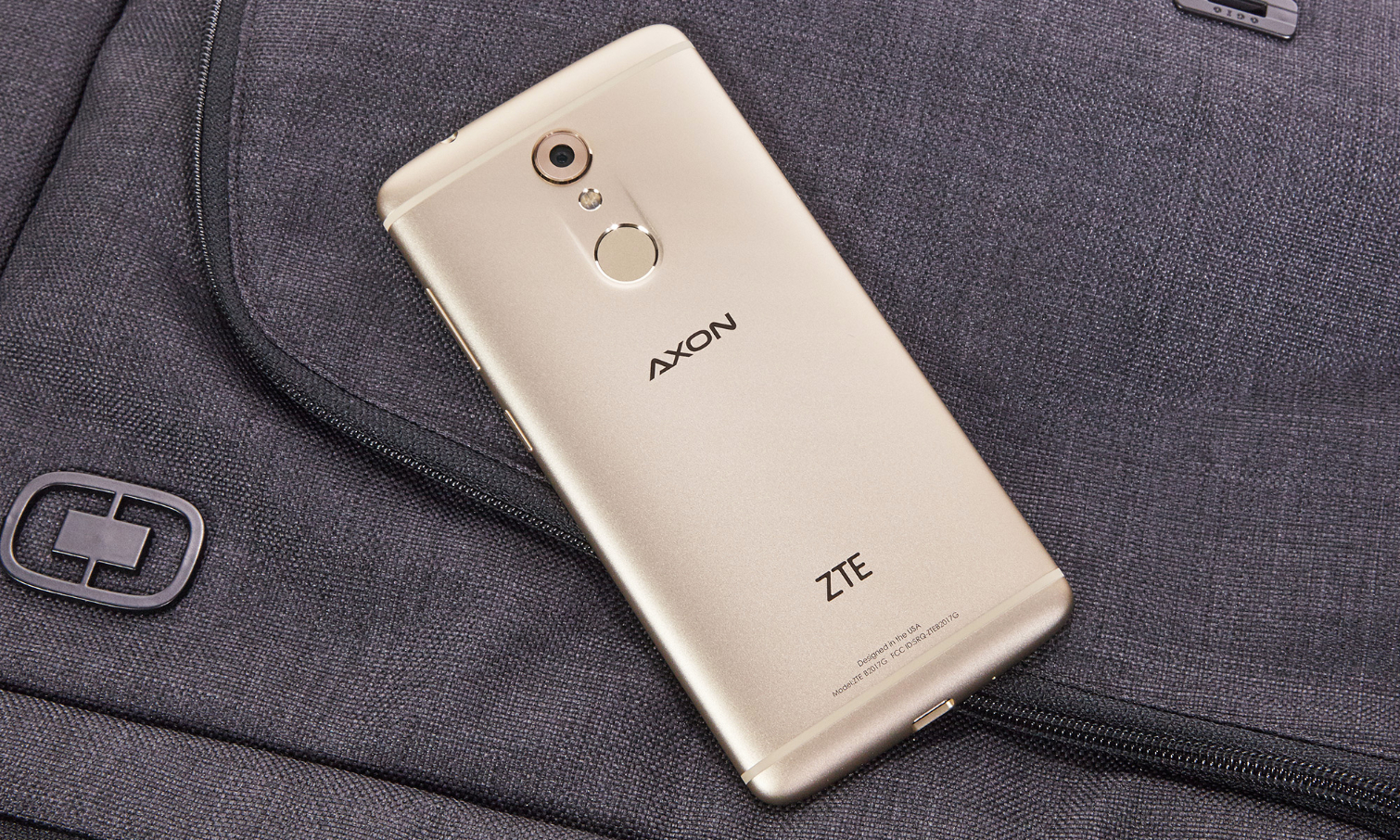
More importantly, the Mini retains the same top-of-the-line look ZTE used on the Axon 7. A snazzy aluminum unibody design features curved edges that make the phone easy to grip. The side bezel feels practically nonexistent, and speakers on the top and bottom contribute to a very good audio experience. I thought the gold version of the phone I tested looked particularly sharp, but you can get the Mini in a platinum gray if you prefer.
The fingerprint sensor is on the back of the phone just below the rear camera lens and flash. In addition to unlocking the phone, you can use the sensor to answer phone calls and snap photos. That latter feature comes in handy mostly for selfies with the front camera. I found using it as a shutter on the rear camera increased the odds of one of my fingers straying into the shot.
MORE: Best Smartphones on the Market Now
Display: Colorful, if a bit dim
The screen size has also slimmed down from the 5.5-inch Axon 7; instead, the Mini uses a 5.2-inch display, though thanks to that minimal bezel, I didn't find it to be at all cramped. Whether streaming an episode of Archer on Netflix or watching a Lego Batman Movie trailer on YouTube, the action filled the Mini's screen.
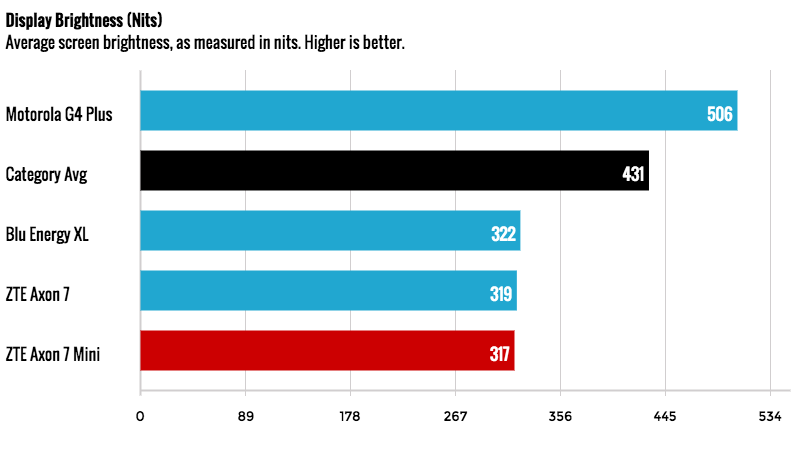
The Mini's display isn't all that bright. Using a light meter, we picked up a reading of 317 nits for the Mini, well below the category average of 431 nits. (The Axon line has a track record of dim screens; we measured the Axon 7 at a nearly identical 319 nits.) While some phones in the Mini's price range tend to have dimmer screens — we measured the $299 Blu Energy XL at 322 nits, for example — a low price tag shouldn't necessarily mean you have to sacrifice screen brightness. The $250 Moto G4 Plus measured 506 nits when we tested it.
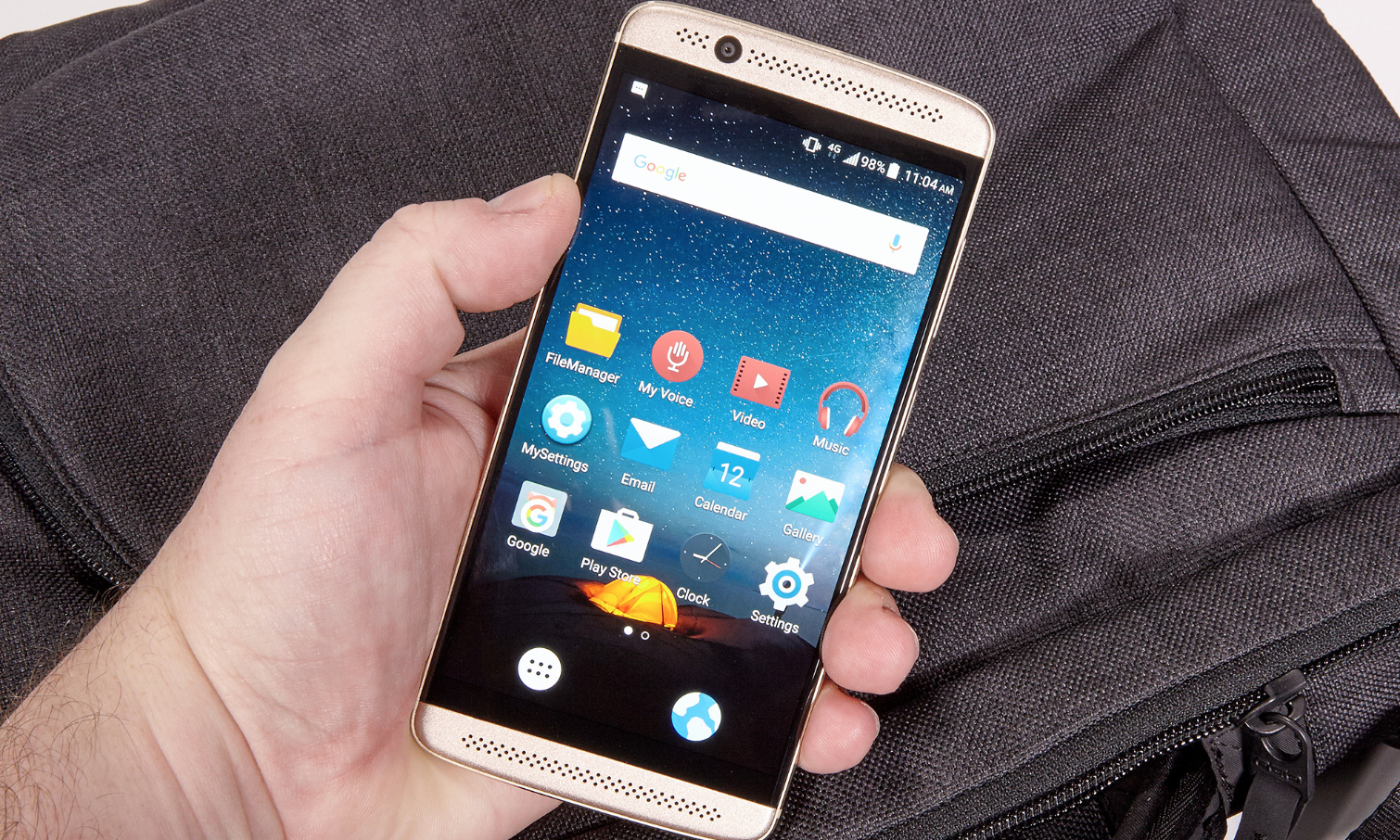
That said, I didn't really have a problem using the Axon 7 Mini outside. I was able to watch that Archer episode in broad daylight and still pick out details, even if the phone's display suffered from a little glare in direct sunlight.
The Mini fares much better with colors, covering 176.9 percent of the sRGB spectrum in our tests. In that Lego Batman trailer, The Joker's hair was nice shock of green, while Batman's cowl looked black and shiny. The colors could be more accurate, though, as we measured a Delta-E rating of 3.92. That's better than the Energy XL's 4.48 rating but not as good as the G4 Plus's 2.33 score. (Numbers closer to zero are better.)
Audio: Superlative sound
ZTE has quite a knack for equipping its phones with superior sound. I think the company's budget Zmax 2 produces some of the best audio I've heard from a smartphone, and the sound on the Axon 7 Mini isn't that far off. In addition to the dual speaker setup, the Mini boasts Dolby Atmos digital surround sound that serves the phone well whether you're listening to music or watching movies.
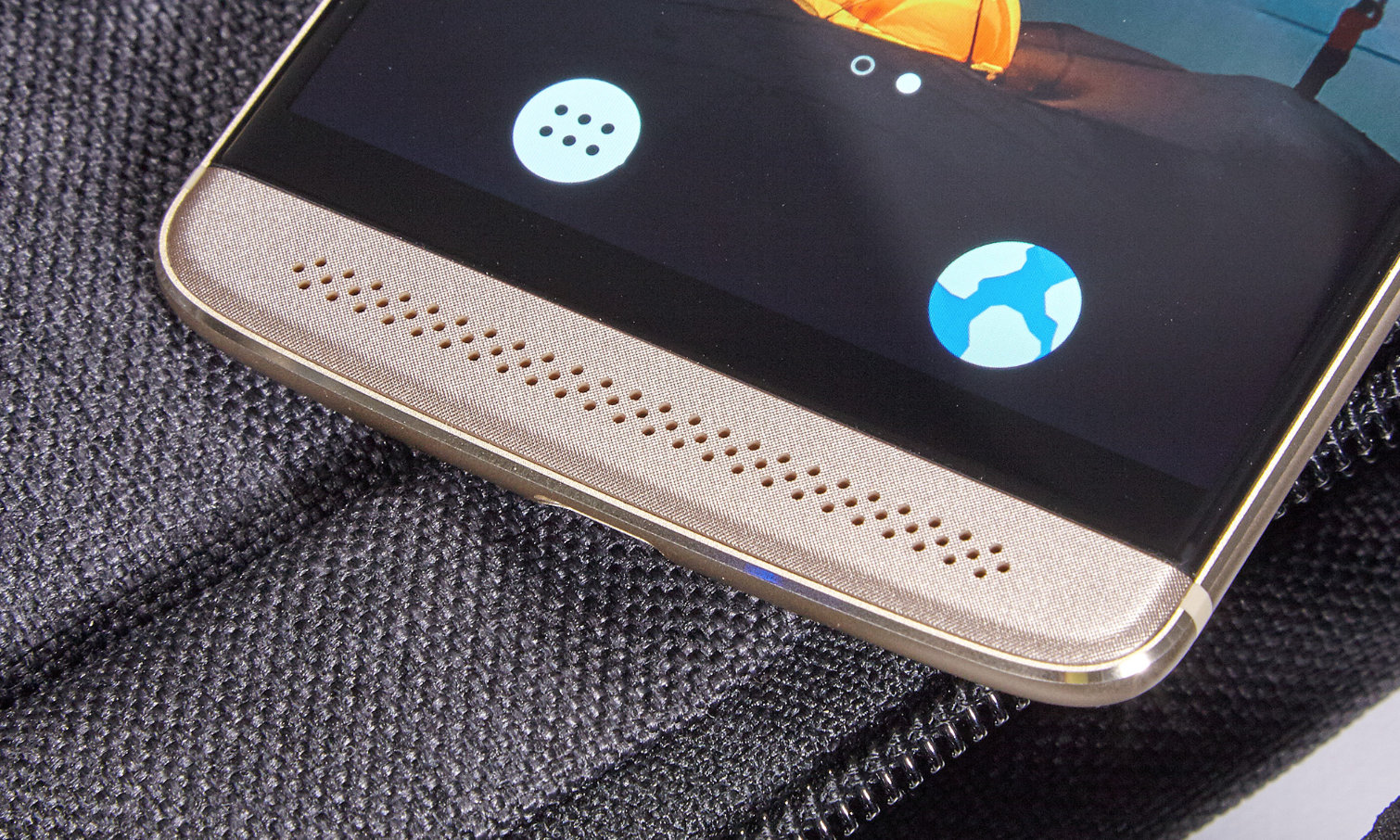
I never had to strain to hear the sharp repartee between Archer and Lana, nor did I have to max out the volume. Bono's vocals on "I Still Haven't Found What I'm Looking For" rang out loud and clear, though there was a slight hiss accompanying Larry Mullen Jr.'s drumming. Similarly, the opening guitar riff on Guns N' Roses' "Sweet Child O' Mine" suffered from a little distortion, but overall, it was a pleasure listening to these songs over the Axon 7 Mini's top-notch speakers.
Performance: Here's where you’ll compromise
To slash prices on their devices, phone makers will often scale back the components inside, and that's what happened with Axon Mini 7. Gone are the top-of-the-line Snapdragon 820 and 4GB of RAM that powered the Axon 7. Instead, the Mini sports a more modest Snapdragon 617 and 3GB of memory.
The impact of that change was apparent during our benchmark testing of the Axon 7 Mini. In the JetStream JavaScript test, the Axon 7 Mini scored a 22.2, a far cry from the 55.2 score turned in by the Mini's more powerful sibling. The Axon 7 Mini compares better to phones also equipped with the Snapdragon 617, like the Moto G4 Plus. Motorola's $250 phone finished slightly ahead of the Mini, with a score of 22.6. (Higher numbers are better in this test.)
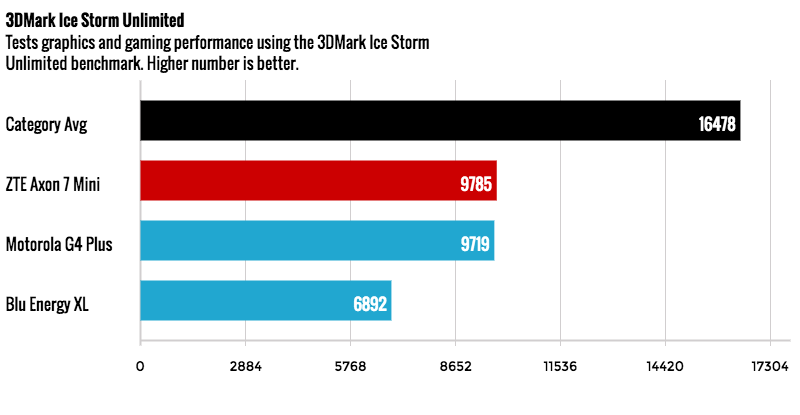
The Axon Mini 7 fared better in graphics benchmarking, scoring a 9,785 in the 3DMark's Ice Storm Unlimited graphics test. That edged out the Moto G4 Plus (9,719) and blew past the Blu Energy XL (6,892), though the average smartphone scores a 16,478 on this test.
MORE: Best Cheap Unlocked Smartphones
Still, I didn't notice any performance lags when using the Axon 7 Mini. Apps opened quickly enough, without noticeable delay. Whether I was blasting enemies in Modern Combat 5 or dodging an unending stream of obstacles on Jetpack Joyride, I was able to play without any pauses or stutters. If you need to use processor-intensive apps, you may want to turn elsewhere, but the Axon 7 Mini is more than capable of handling the kinds of tasks most mobile users will throw at it.
Camera: The better the light, the better the shot
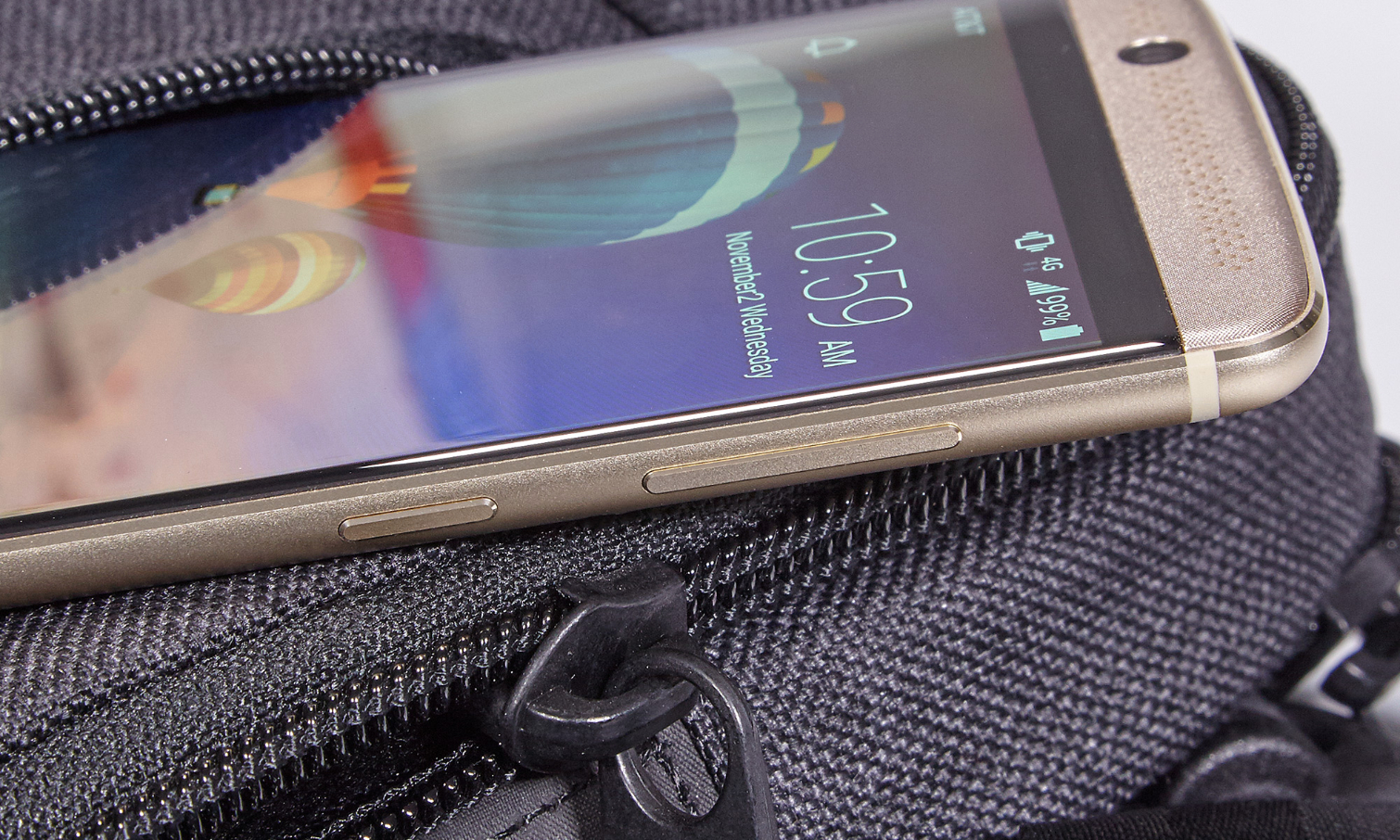
The 16-megapixel rear camera on the Axon 7 Mini is a step down from the Axon 7's 20-MP shooter. But you won't notice too much of a trade-off in image quality with this less expensive ZTE phone. The Mini can't compete with the high-end camera phones, but it still produces some pretty sharp-looking photos so long as the light is right.

Consider these pumpkins lined up on my porch. You can really make out the textures on the greenish pumpkins in the foreground, and though the orange pumpkin off to the side isn't as sharp, its color still pops. The ginkgo littering the steps look like individual leaves instead of an amorphous mass.

I was also impressed by this shot of some flowers in broad daylight, which is even sharp enough to make out the bee that buzzed into view while I was snapping the picture. I would note that this is the second of two photos I took of these same flowers, as the first one looked too blurry for my tastes.

The Axon 7 Mini can handle action shots fairly well in good light. A photo of my daughter demonstrating her tetherball prowess blurs the swinging ball and my daughter's moving feet only slightly. The rest of the shot remains pretty well-focused, with some bright blues on my daughter's clothing.

At night, the Mini's camera struggles a little bit. The colors look OK in this photo of a plate of barbecue ribs with sides. You can certainly pick out the contrast in the different-colored sauces. But the individual kernels of corn lose their sharpness, and the IPA in the background looks fuzzy and indistinct. Using the camera's flash sharpened some of the images in the photo but gave the colors an unnatural hue.

A fire pit outside the barbecue joint fails to stand out. The flames blur together, and individual features — exits signs, nearby traffic signals, a TV hanging over the restaurant's patio — blend indistinctly into the background.
MORE: How Many Megapixels Do You Really Need?
The Axon 7 Mini offers some decent manual controls for adjusting focus, white balance, ISO and shutter speed, which you can use if you like to tinker with your shots before you take them. The camera also offers a live-photos feature similar to what you'll find on Apple's recent iPhones, in which the camera records a few seconds of motion to go with the still image (though the Mini doesn't capture audio). The feature is off by default, but it's easy enough to turn it on by tapping the appropriate button on the camera's screen.
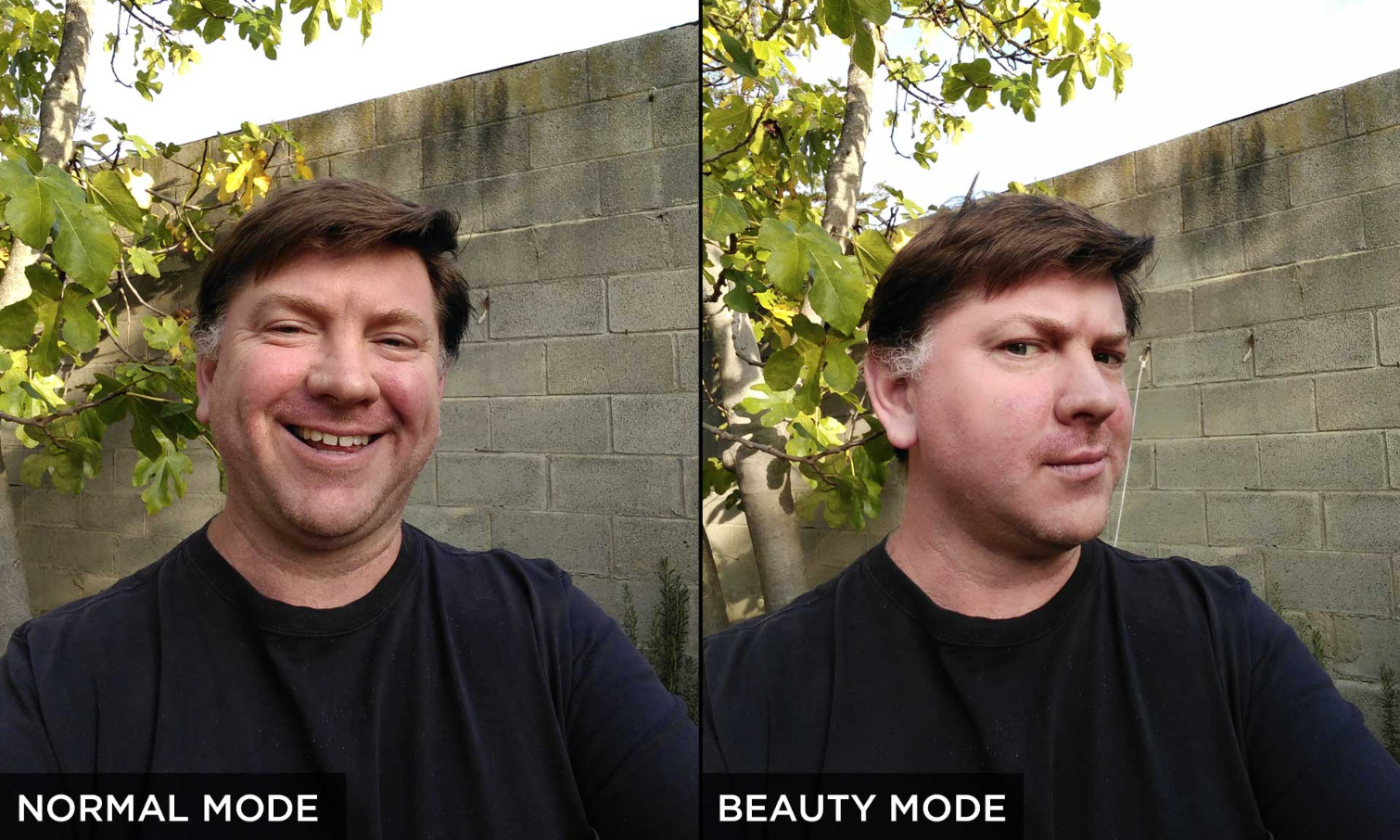
I was less pleased with the 8-MP front camera, but mostly because it launches in Beautify mode by default. Selfies shot in Beautify aggressively smoothed out my skin, giving my face an unnatural look. My face looked much better with Beautify turned off — my skin tone looked more natural and less air-brushed — but the cloudy sky behind me looked washed out. Things get worse as conditions get less ideal, with selfies shot indoors in poor lighting producing noisy images.
Battery Life: Far too short
The Axon 7 Mini's 2,705-mAh battery doesn't pack enough power to get you through the day. That became clear after 3 hours of benchmarking, gaming, video streaming and photo shooting wiped out 40 percent of the phone's battery life. And the Tom's Guide battery test, which involves continuous web surfing over AT&T's LTE network, confirmed that impression.
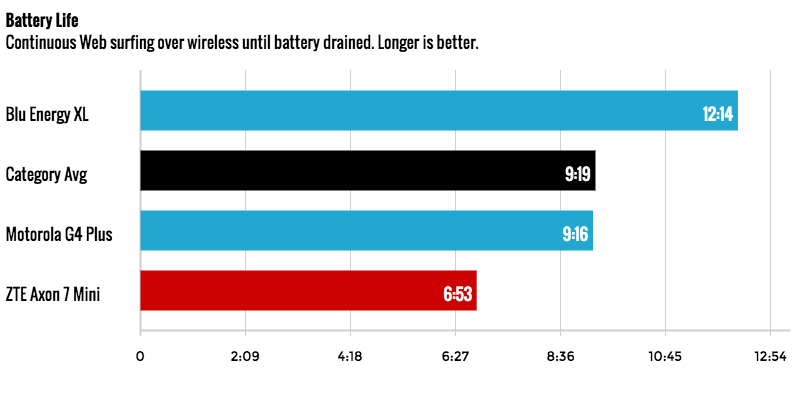
The Axon 7 Mini ran out of power after 6 hours and 53 minutes. That's well below the 9:19 average for smartphones. More significantly, it's not even up to snuff for phones in this price range. The Blu Energy XL — which makes battery life its calling card on our test — lasted more than 12 hours, while the Moto G4 Plus held out for 9:16.
At least you'll be able to power up quickly, thanks to the Axon 7 Mini's support for Quick Charge 2.0. I plugged in my Mini when its battery was down to 78 percent. After 23 minutes, the battery was 94 percent charged.
MORE: Smartphones with the Longest Battery Life
Software: A clean version of Android
If you like a clean Android experience, you'll feel right at home with the Axon 7 Mini. It runs ZTE's MiFavor skin on top of Android Marshmallow, but that doesn't get in the way of anything. ZTE even supports some very helpful features, like double-tapping the screen to wake up the Mini or using a three-finger pinch to take a screenshot.
An unlocked phone that runs on GSM networks — that's AT&T and T-Mobile here in the U.S. — the Mini offers very little in the way of software bloat. ZTE's My Voice app even adds some functionality, by letting you unlock your phone, take photos and play music using voice commands.
If I have a complaint about the Mini's software setup, it's that it seems to use the TouchPal keyboard by default. It's very easy to switch over to a more standard keyboard, though, so that's a very minor gripe.
Bottom Line
There's a lot to recommend the Axon 7 Mini if you're in the market for a phone that won't break the bank. This device retains the same great design as the flagship-challenging Axon 7, while making acceptable trade-offs in performance to keep the price low. The rear camera can turn out some pretty good-looking images, and watching videos on that vibrant screen with stereo sound is a pleasure.
But I keep coming back to the Axon 7 Mini's poor battery life. Get this phone, and you're giving up all hope of making it to dinnertime without having to look for a charging port. In a world where you can get other phones for $250 to $300 — both the Moto G4 Plus and Blu Energy XL outlast the Mini — it's really hard to overlook the ZTE phone's major flaw.
Philip Michaels is a Managing Editor at Tom's Guide. He's been covering personal technology since 1999 and was in the building when Steve Jobs showed off the iPhone for the first time. He's been evaluating smartphones since that first iPhone debuted in 2007, and he's been following phone carriers and smartphone plans since 2015. He has strong opinions about Apple, the Oakland Athletics, old movies and proper butchery techniques. Follow him at @PhilipMichaels.
-
Oliver_52 Have you tried making phone calls with it? I have this phone and unless I put *31# before the numbers I dial all my calls go through without my number being sent.Reply

